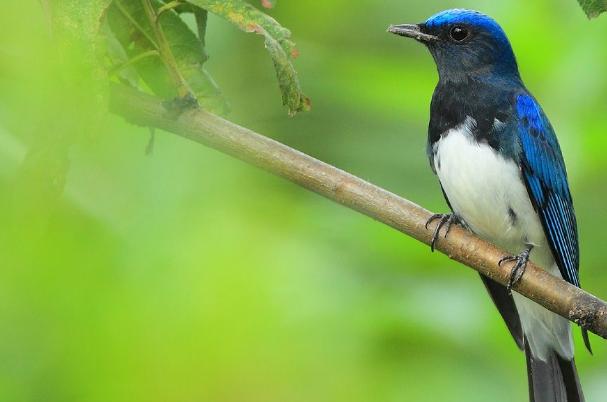White-bellied bluebird (scientific name: Cyanoptila cyanomelana): 14–17 cm long, small bird. The male white-bellied bluebird has a black frontal base, eye front, and chin tip, sky blue or cobalt blue from the top of the head to the back of the neck, purple or blue blue on the back, shoulders, waist and tail coverts, the inner coverts of the wings are the same color as the back, the outer coverts are black brown, and the outer coverts are purple and blue-blue, so the surface is still the same color as the back. The winglet feathers are black, the flight feathers are black brown, the outer feather margins are blue or greenish blue, the central pair of tail feathers are blue or dark blue, the base is black, the rest of the tail feathers are outer blue or dark blue, the inner feathers are dark brown, and the base of the tail feathers is white. The sides of the head, chin, throat, and thorax are black or bluish-blue, with white below the thorax and dark grey flanks. The female has olive-brown upperparts, ash on the sides of the head and neck, rusty brown on the waist and tail coverts, rusty brown tail, black brown upper wing coverts, olive-brown feathers, black-brown flight feathers, and light rusty brown outer feather margins. The chin and throat are stained white, the thorax and flanks are pale greyish brown or grey, and the ventral and undertail coverts are white. The iris is dark brown or black brown, the mouth is dark brown, and the feet are black.

Distribution in China Hainan, Beijing, Liaoning, Northeast China and other places,
It inhabits mainly montane broad-leaved forests and mixed forests, especially along forest margins and steep streams, and in nearby forest areas with steep rocks or bumps. Individual or paired events. When first moved to the breeding ground, it is more active in the secondary forest and shrubland of the forest edge, and the male birds often stand on the tall trees near the river valleys and streams, and can hear the call at the latest after sunset, crisp and gentle, pleasant to the ear, for a series of whistles. When singing, the female often hides in the nearby understory bushes, extremely hidden, hearing the song of the male, sometimes flying to the branches of the small branches near the male, and making the same song as the male, but the voice is low. The male bird hears the female bird respond, constantly nods, cocks its tail, and then flies to the female bird, crouching on the back of the female bird to cross the tail, the tail time is extremely short, and then the female bird flies away, and the male chases tightly. Flying each other in the jungle, flying fast, but not far away. Feeds mainly on insects and insect larvae. The main foods eaten are Lepidoptera larvae, kowtows, goldenrods, weevils, scarab beetles, silkworm moth larvae, stone moth family larvae, plankton, stone fly adults, butterfly larvae, cicada larvae, pseudo-inchworm larvae, nocturnal moth larvae, walking insects, spiders, adults of the family Macrophyllaceae, locusts, etc.
The breeding period is from May to July, as early as early May, when individuals begin to nest, mostly in mid-to-late May, by the male and female parent birds to bear the burden. Nests usually lie on steep banks and slopes on the banks of streams and river valleys in the forest, as well as on the banks of and nearby cliffs in and around the forest edge valley. Nests are mostly placed in exposed cliff caves, steps or crevices and between the natural burrows and roots of elm trees, rat plums, colored trees, linden trees, birch trees and other trees near the riverbank. The tallest tree hole is more than 20 meters above the ground. After reaching the breeding ground, the male birds look for nests and occupy the area to chirp, often standing on the top of high trees and singing endlessly, declaring the possession of the field and driving away intruders. The nest is cup-shaped, made entirely of moss, and lined with a few plant fibers, fine roots, animal hair, and bird feathers. Eggs are laid immediately after nesting, with 3-5 eggs laid per clutch, white or milky white, with some blunt ends with an inconspicuous brown spot.